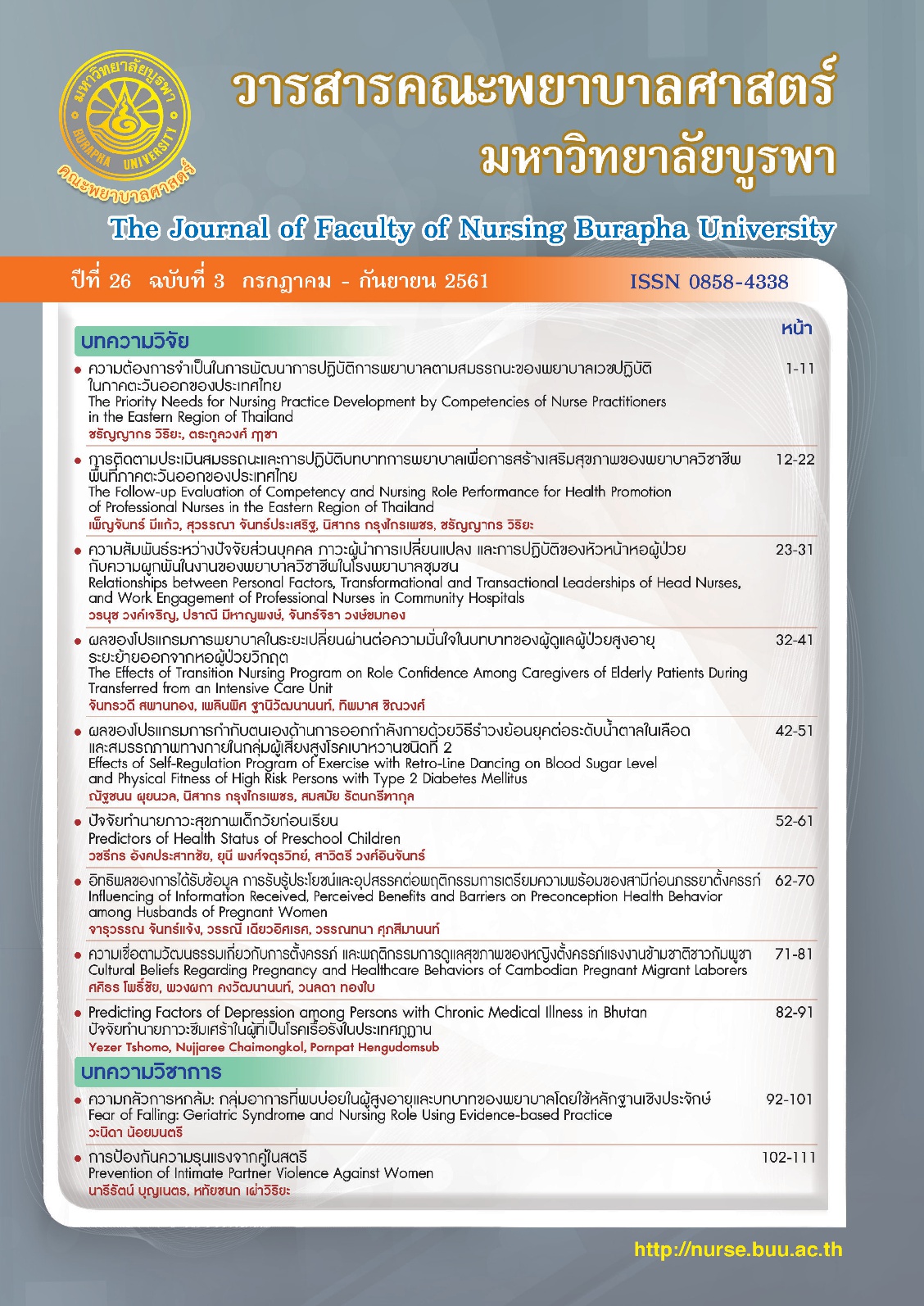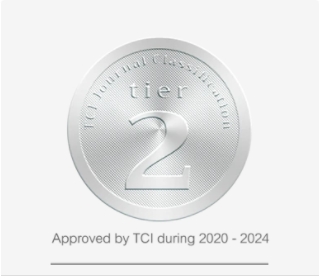ความสัมพันธ์ระหว่างปัจจัยส่วนบุคคล ภาวะผู้นำการเปลี่ยนแปลง และการปฏิบัติของหัวหน้าหอผู้ป่วย กับความผูกพันในงานของพยาบาลวิชาชีพในโรงพยาบาลชุมชน
คำสำคัญ:
หัวหน้าหอผู้ป่วย, ภาวะผู้นำการเปลี่ยนแปลง, ภาวะผู้นำการปฏิบัติ, ความผูกพันในงาน, พยาบาลวิชาชีพบทคัดย่อ
บทคัดย่อ
การวิจัยนี้มีวัตถุประสงค์เพื่อศึกษาความสัมพันธ์ระหว่างปัจจัยส่วนบุคคล ภาวะผู้นำการเปลี่ยนแปลง และการปฏิบัติของหัวหน้าหอผู้ป่วย กับความผูกพันในงานของพยาบาลวิชาชีพในโรงพยาบาลชุมชน กลุ่มตัวอย่างคัดเลือกโดยวิธีการสุ่มแบบหลายขั้นตอน เป็นพยาบาลวิชาชีพที่ปฏิบัติงานในโรงพยาบาลชุมชนขนาดกลางเป็นระยะเวลาตั้งแต่ 1 ปีขึ้นไป จำนวน 314 คน เก็บรวบรวมข้อมูลเดือนตุลาคม ถึงเดือนพฤศจิกายน 2560 เครื่องมือการวิจัย ได้แก่ แบบสอบถามภาวะผู้นำการเปลี่ยนแปลงของหัวหน้า แบบสอบถามภาวะผู้นำการปฏิบัติของหัวหน้า และแบบสอบถามความผูกพันในงาน มีค่าความเชื่อมั่นเท่ากับ .94, .70 และ .87 ตามลำดับ วิเคราะห์ข้อมูลด้วยสถิติพรรณนา และค่าสัมประสิทธิ์สหสัมพันธ์ของเพียร์สัน
ผลจากการวิจัย พบว่าความผูกพันในงานมีค่าเฉลี่ยเท่ากับ 3.72 (SD=.55) ซึ่งอยู่ในระดับมาก ภาวะผู้นำการเปลี่ยนแปลง และภาวะผู้นำการปฏิบัติของหัวหน้ามีความสัมพันธ์ทางบวกกับความผูกพันในงานอย่างมีนัยสำคัญทางสถิติ (r = .468, p<.001 และ r = .398, p<.001) ผลการวิจัยให้ข้อเสนอแนะว่า หัวหน้าหอผู้ป่วยควรมีภาวะผู้นำทั้งการเปลี่ยนแปลงและการปฏิบัติอยู่ในระดับมาก เพื่อส่งผลต่อพยาบาลวิชาชีพในหอผู้ป่วยนั้นให้มีความผูกพันในงานมากด้วย โดยเฉพาะอย่างยิ่งในโรงพยาบาลชุมชนระดับกลาง
References
Set. (3rd ed.). Redwood City, CA: Mind Garden.
Chupan, S., Khumyu, A., Vatanasin, S., & Vatanasin, D. (2017). Factors influencing intention to
stay in career among professional nurses. The Journal of Factory of Nursing Burapha
University, 25(4), 1-10. [In Thai]
Devi, V. R., & Narayanamma, P. L. (2016). Impact of leadership style on employee engagement. Pacific Business Review International, 1(1), 91-98.
Hayati, D., Charkhabi, M., & Naami, A. (2014). The relationship between transformational leadership and work engagement in governmental hospitals nurses: A survey study.
Springer Plus, 3(25), 1-7.
Jaemtim, N. (2014). Antecedents of engagement and empowerment impact on job
performance and organization citizenship behavior of nursing instructors of Boromarajonani college of nursing, the Ministry of Public Health (Doctoral dissertation). Educational administration, department of education, Kasetsart University. [In Thai]
Jongpermwattnaphon, J., & Kaewkong, C. (2014). Factors affecting to staff’s work
engagement at Kamphaengsaen hospital, Nakhon Pathom province (Master’s thesis). Kasetsart University. [In Thai]
Kittimanont, H. (2014). A causal model of health professional personnel performances in the
university hospitals in Thailand (Doctoral dissertation). Hospital management, Christian University. [In Thai]
Kongsuwan, W. (2010). A causal model of nursing learning organization in public university
hospital (Doctoral dissertation). Nursing management, Christian University. [in Thai]
Krejcie, R. V., & Morgan, D. W. (1970). Determining sample size for research activities.
Educational and psychological measurement, 30(3), 607-610.
Lamounpuk, S. (2016). Multilevel antecedents and effects of professional engagement on
job performance and Intention to leave nursing profession of professional nurses in
governmental hospitals, Bangkok metropolitan area (Doctoral dissertation). Applied behavioral science research, Srinakharinwirot University. [In Thai]
Meehanpong, P., & Sritoomma, N. (2016). The leadership of head nurses and the patient unit
performance. The Journal of Factory of Nursing Burapha University, 24(4), 15-22. [In Thai]
Muanlamai, S. (2013). Self-efficacy, job characteristics, organizational climate affecting the
work engagement of registered nurses at Ramkhamheang hospital. Dusit Thani College Journal, 7(2), 68-90. [In Thai]
Salanova, M., Lorente, L., Chambel, M. J., & Martınez, I. M. (2011). Linking transformational
leadership to nurses’ extra-role performance: The mediating role of self-efficacy and
work engagement. Journal of Advanced Nursing, 67(10), 2256-2266.
Saks, A. M., & Gruman, J. A. (2014). What do we really know about employee engagement?
Human Resource Development Quarterly, 23(2), 155-182.
Sashkin, M., & Sashkin, M.G. (2003). Leadership that matters. San Francisco: Barrett-Kochler
Publisher, Inc.
Sawangdee, K. (2016). Insights into the health system; Thai nursing shortage. Retrieved from
https://www.hfocus.org/content/2016/03/11933. [in Thai]
Schaufeli, W. B., Bakker, A. B., & Salanova, M. (2006). The measurement of work engagement with a short questionnaire. Educational and Psychological Measurement, 66(4), 701-
716.
Simpson, M. R. (2009). Predictors of work engagement among medical-surgical registered
nurses. Western Journal of Nursing Research, 31(1), 44-64.
Smithikrai, C., & Pusapanich, P. (2017). Factors influencing work engagement and organizational commitment of Chiang Mai University staff. Kasetsart Journal of Social
Sciences, 38, 655-667. [In Thai]
Thara, K. (2009). Nursing work values: Meanings and experiences of professional nurses.
(Master’s thesis). Nursing Administration, Chulalongkorn University. [In Thai]
Wongrot, P. & Varitsakul, R. (2015). Factors affecting the emergency medical service-related
work engagement of emergency medical service providers under Thai local government organizations. Journal of Public Health Nursing, 29(3):65-77. [In Thai]





